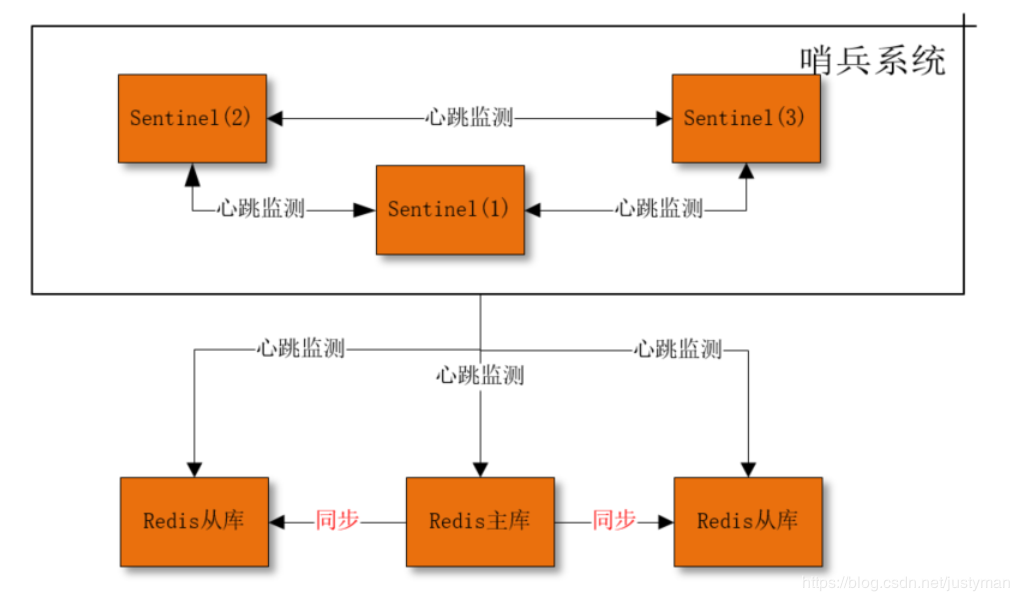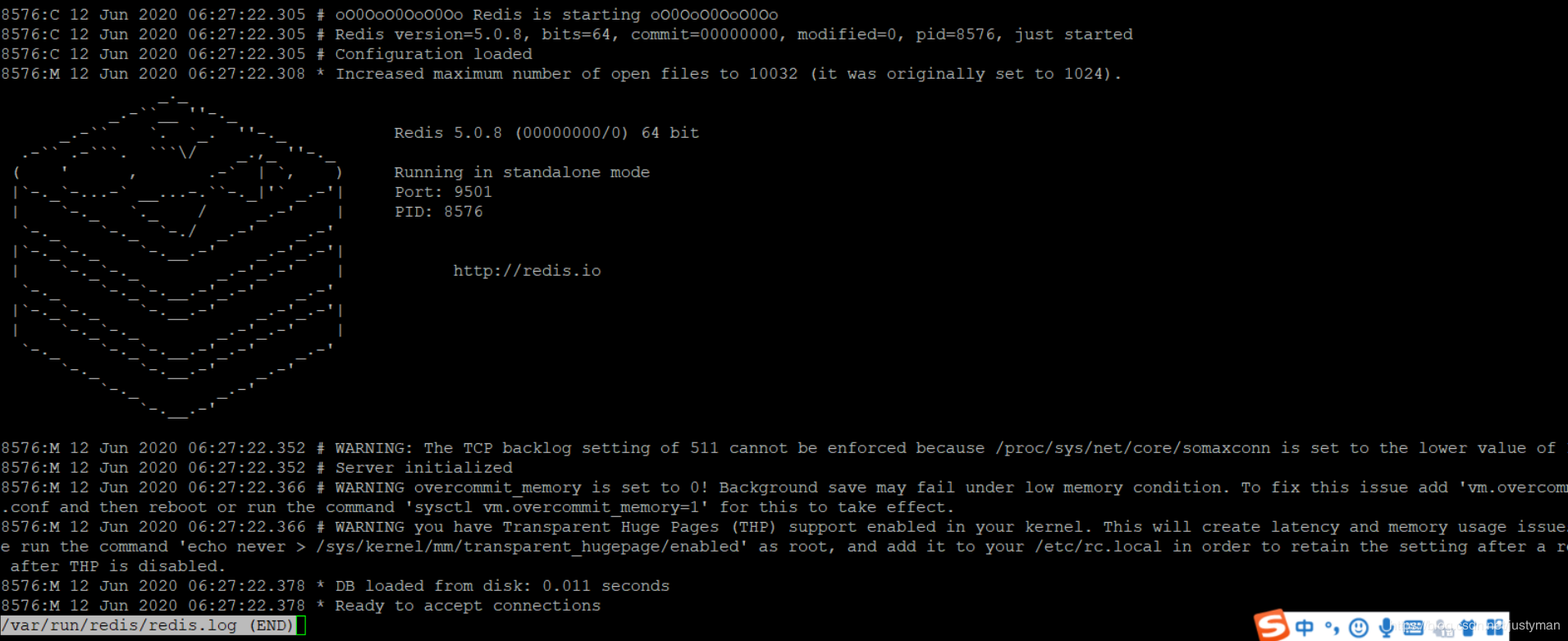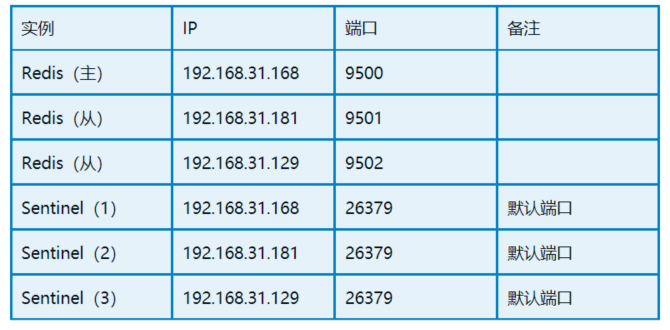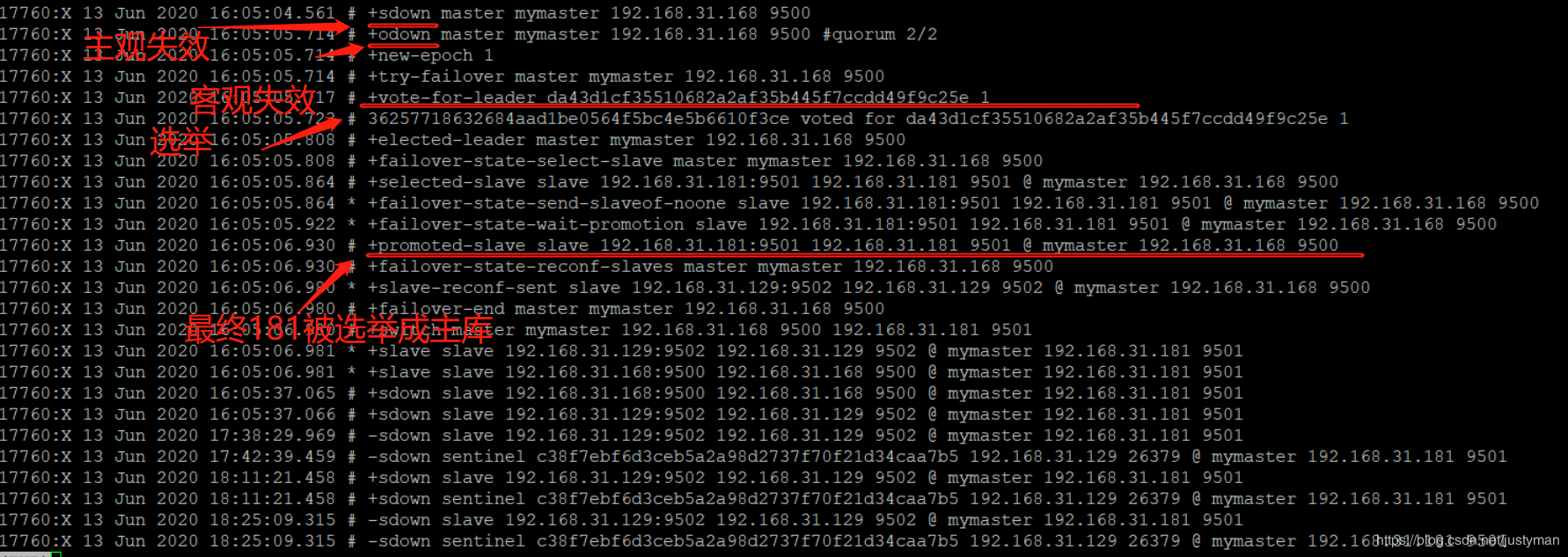玩转 Redis 高可用 - 哨兵(Sentinel)模式

一、前言
本人所负责的团队里也广泛使用 Redis,但是集群模式也有很多种,有三主三从,有一主两从三哨兵、Cluster 集群等。具体部署方式根据业务系统的重要程度,但记住哨兵尽量是奇数个,因为要避免发生脑裂。三主三从这个确实可以最完整的保证数据的完整性,但是所需要的服务器资源也是最多的。在一般情况,统筹兼顾数据完整性和方案经济性,一般最优解是采用一主两从三哨兵的模式。
本着总结是为了更好的运用,这里就大致整理一下之前项目中使用的 Redis 哨兵模式(Sentinel)的搭建方式,并演示一下数据如何同步,故障如何自动转移。
二、何为哨兵模式
首先, 哨兵模式是一种特殊的模式,它是 Redis 高可用的一种实现方案。首先哨兵是一个独立的进程, 可以实现对 Redis 实例的监控、通知、自动故障转移。具体如下:
监控(Monitoring):
哨兵(sentinel) 会不断地检查你的 Master 和 Slave 是否运作正常。
提醒(Notification):
当被监控的某个 Redis 出现问题时, 哨兵(sentinel) 可以通过 API 向管理员或者其他应用程序发送通知。
自动故障迁移(Automatic failover):
当一个 Master 不能正常工作时,哨兵(sentinel) 会开始一次自动故障迁移操作,它会将失效 Master 的其中一个 Slave 升级为新的 Master, 并让失效 Master 的其他 Slave 改为复制新的 Master; 当客户端试图连接失效的 Master 时,集群也会向客户端返回新 Master 的地址,使得集群可以使用 Master 代替失效 Master。
这里先发个拓扑图可能会更加容易理解。
实际上,每个哨兵节点每秒通过 ping 去进行心跳监测(包括所有 redis 实例和 sentinel 同伴),并根据回复判断节点是否在线。
如果某个 sentinel 线程发现主库没有在给定时间( down-after-milliseconds)内响应这个 PING,则这个 sentinel 线程认为主库是不可用的,这种情况叫“主观失效”(即 SDOWN);这种情况一般不会引起马上的故障自动转移,但是当多个 sentinel 线程确实发现主库是不可用并超过 sentinel.conf 里面的配置项 sentinel monitor mymaster {#ip} {#port} {#number}中的 #number 时候(这里实际上采用了流言协议),一般其余 sentinel 线程会通过 RAFT 算法推举领导的 sentinel 线程负责主库的客观下线并同时负责故障自动转移,这种情况叫“客观失效”(即 ODOWN)。
*** 流言协议【Gossip Protocol】,具体的流言协议请参考搜狐的一篇文章 https://www.sohu.com/a/302002994_467784

三、Redis 环境搭建
1、安装 gcc 依赖
gcc 是什么?gcc 实际上就是 linux 下面的多语言编译器(以前一开始只支持 C),所以它的全称也叫 GNU Compiler Collections。例如你下载个 Redis 等都是需要进行编译安装。废话不多说,先开始安装吧。
#先检查你的 centos 之前有没有安装过 gcc。如有有以下 echo 即证明已安装。
[root@centos7a local]# gcc -v
Using built-in specs.
COLLECT_GCC=gcc
COLLECTLTOWRAPPER=/usr/libexec/gcc/x86_64-redhat-linux/4.8.5/lto-wrapper
Target: x86_64-redhat-linux
Configured with: ../configure --prefix=/usr --mandir=/usr/share/man --infodir=/usr/share/info --with-bugurl=http://bugzilla.redhat.com/bugzilla --enable-bootstrap --enable-shared --enable-threads=posix --enable-checking=release --with-system-zlib --enable-_cxaatexit --disable-libunwind-exceptions --enable-gnu-unique-object --enable-linker-build-id --with-linker-hash-style=gnu --enable-languages=c,c++,objc,obj-c++,java,fortran,ada,go,lto --enable-plugin --enable-initfini-array --disable-libgcj --with-isl=/builddir/build/BUILD/gcc-4.8.5-20150702/obj-x8664-redhat-linux/isl-install --with-cloog=/builddir/build/BUILD/gcc-4.8.5-20150702/obj-x8664-redhat-linux/cloog-install --enable-gnu-indirect-function --with-tune=generic --with-arch32=x86-64 --build=x8664-redhat-linux
Thread model: posix
gcc version 4.8.5 20150623 (Red Hat 4.8.5-39) (GCC)
#如果没有,就通过yum安装吧,具体命令如下:
yum install gcc
2、下载 redis 安装包
1、这里以 5.0.8 为例,首先下载 redis 包
[root@centos7a local]# wget http://download.redis.io/releases/redis-5.0.8.tar.gz
--2020-06-05 20:48:59-- http://download.redis.io/releases/redis-5.0.8.tar.gz
Resolving download.redis.io (download.redis.io)... 109.74.203.151
Connecting to download.redis.io (download.redis.io)|109.74.203.151|:80... connected.
HTTP request sent, awaiting response... 200 OK
Length: 1985757 (1.9M) [application/x-gzip]
Saving to: ‘redis-5.0.8.tar.gz’
100%[=============================================================>] 1,985,757 30.2KB/s in 88s
2020-06-05 20:50:27 (22.1 KB/s) - ‘redis-5.0.8.tar.gz’ saved [1985757/1985757]
2、解压
[root@centos7a local]# tar -zxvf redis-5.0.8.tar.gz
#注意
如果gcc版本过低,在安装redis 6.0.0以上会报这类错误 => make[1]: *** [server.o] Error 1。一般的解决方案:1)升级gcc版本;2)安装低版本的redis;
博主懒得升级gcc,因此选择后者,直接安装5.0.8版本,一路通关无障碍。
3、编译安装
#1、进入安装目录
[root@centos7a local]# cd redis-5.0.8/
[root@centos7a redis-5.0.8]# pwd
/usr/local/redis-5.0.8
#2、开始编译安装
[root@centos7a redis-5.0.8]# make MALLOC=libc
cd src && make all
make[1]: Entering directory `/usr/local/redis-5.0.8/src'
CC Makefile.dep
.....
.....
INSTALL redis-check-aof
Hint: It's a good idea to run 'make test' ;)
make[1]: Leaving directory `/usr/local/redis-5.0.8/src'
3、修改配置 (/usr/local/redis-5.0.8/redis.conf)
#1、redis默认不是以线程守护的方式运行的,如需要调整至线程守护的方式,请把
daemonize no => daemonize yes
#2、把默认端口6379改为其他
port 6379 => port 9500
#3、bind会限制能够访问redis的地址,默认(127.0.0.1)是指本地才能访问。如果要放开redis,如要搭建redis集群的话,要把bind注释掉;同时要把protected-mode从yes改为no
#bind 127.0.0.1
protected-mode yes => protected-mode no
#4、把PID文件名改成跟修改后的PORT一致
pidfile /var/run/redis_9500.pid
#5、设定日志文件路径
logfile "/var/run/redis/redis.log"
4、通过 systemd 进行服务启停管理
#1、 在/lib/systemd/system/目录下新建文件redis.service,并加入以下内容并保存
[Unit]
Description=Redis
After=network.target
[Service]
ExecStart=/usr/local/redis-5.0.8/src/redis-server /usr/local/redis-5.0.8/redis.conf --daemonize no
ExecStop=/usr/local/redis-5.0.8/src/redis-cli -h 127.0.0.1 -p 9500 shutdown
[Install]
WantedBy=multi-user.target
#2、刷新配置
systemctl daemon-reload
#3、直接就可以使用systemctl进行start/stop/restart
systemctl start redis.service //启动
systemctl restart redis.service //重启
systemctl stop redis.service //关停
systemctl enable redis.service //设置成开机启动
只要在日志文件中看到如下日志,那就代表 redis 已经启动了。

5、测试 redis 数据库
1、从下面的命令可以看到Redis已经启动并提供服务
[root@centos7a system]# netstat -tunlp|grep redis
tcp 0 0 0.0.0.0:9500 0.0.0.0:* LISTEN 10331/redis-server
tcp6 0 0:::9500 :::* LISTEN 10331/redis-server
2、对Redis进行一系列操作
[root@centos7a src]# ./redis-cli -h 127.0.0.1 -p 9500
127.0.0.1:9500> SET K1 LIWENJIE
OK
127.0.0.1:9500> KEYS *
1) "K1"
2) "K3"
3) "K2"
127.0.0.1:9500> DEL K1
(integer) 1
127.0.0.1:9500> EXPIRE K2 1000
(integer) 1
127.0.0.1:9500> TTL K2
(integer) 997
127.0.0.1:9500> PERSIST K2
(integer) 1
127.0.0.1:9500> TTL K2
(integer) -1
6、重复安装另外两台
从以上 6 个步骤来看,一台 Redis 的搭建是不是特别容易就搞定呢?接下来的就是重复上面的步骤搭建另外两个 Redis。
四、哨兵模式设置
1、这里我们采用的一主两从三哨兵的模式进行介绍,下面列出相应的服务器信息。

2、首先,修改每个 redis 服务器对应的 redis.conf 文件(如下)。
1、 首先,把 IP 绑定改为绑定对应服务器内网 IP. (三个 redis 实例的都要修改)
2、因为这里是以 192.168.31.168 这台作为主库,因此只需要修改 181 和 129 这两台从库的以下配置项(只需要修改两个从 redis 实例)
# 这里请注意,5.0 版本之前是使用 slaveof,5.0 版本之后的配置使用 replicaof,但是因为向下兼容的原则,就算你在 5.0 的版本中使用 slaveof 也不会有问题,但一般建议有新的就用新的吧,否则某天如果突然不支持旧的 slaveof 就 GG 了。
replicaof 192.168.31.168 9500
3、修改每个 sentinel.conf(如下)
[root@centos7a redis-5.0.8]# grep -Ev "^$|#" sentinel.conf #先grep出来展示有什么属性项
port 26379
# 是否后台运行
daemonize no
# 运行时的pid文件
pidfile /var/run/redis-sentinel.pid
# sentinel日志文件
logfile ""
# 工作目录
dir /tmp
# 这里定义主库的IP和端口,还有最后的2表示要达到2台sentinel认同才认为主库已经挂掉(即客观失效),后面科普
sentinel monitor mymaster 127.0.0.1 6379 2
# 主库在30000毫秒(即30秒)内没有反应就认为主库挂掉(即主观失效)
sentinel down-after-milliseconds mymaster 30000
# 若新主库当选后,允许最大可以同时从新主库同步数据的从库数
sentinel parallel-syncs mymaster 1
# 若在指定时间(即180000毫秒,即180秒)内没有实现故障转移,则会自动再发起一次
sentinel failover-timeout mymaster 180000
sentinel deny-scripts-reconfig yes
1、修改日志文件
logfile "/var/log/sentinel.log"
2、修改主库的IP和端口
sentinel monitor mymaster 192.168.31.168 9500 2
3、设置成后台运行
daemonize yes
4、其他如无特别就不用修改
4、把 redis-sentinel 设置成 systemd 启动
#1、 在/lib/systemd/system/目录下新建文件redis-sentinel.service,并加入以下内容并保存
[Unit]
Description=Redis
After=network.target
[Service]
ExecStart=/usr/local/redis-5.0.8/src/redis-sentinel /usr/local/redis-5.0.8/sentinel.conf –sentinel
ExecStop=/usr/local/redis-5.0.8/src/redis-cli -p 26379 shutdown
[Install]
WantedBy=multi-user.target
#2、刷新配置
systemctl daemon-reload
5、使用以下命令启动 Redis 和 Sentinel,具体顺序为:Redis(主)-> Redis(从)->Redis(从)->Sentinel(1)->Sentinel(2)->Sentinel(3)
Redis:systemctl start redis.service
Sentinel:./redis-sentinel /usr/local/redis-5.0.8/sentinel.conf
启动完后,通过以下命令可以确认主从关系已经确立。
[root@centos7a src]# ./redis-cli -h 192.168.31.168 -p 9500
192.168.31.168:9500> info replication
Replication
role:master
connected_slaves:2
slave0:ip=192.168.31.181,port=9501,state=online,offset=2235966,lag=1
slave1:ip=192.168.31.129,port=9502,state=online,offset=2235966,lag=1
master_replid:1df20ecc0df92307ef811e9bd81cc09e131725c7
master_replid2:0000000000000000000000000000000000000000
masterreploffset:2236538
........
[root@mimy-centos7b src]# ./redis-cli -h 192.168.31.181 -p 9501
192.168.31.181:9501> info replication
Replication
role:slave
master_host:192.168.31.168
master_port:9500
masterlinkstatus:up
masterlastio_seconds_ago:0
mastersyncin_progress:0
slavereploffset:2317523
........
[root@localhost src]# ./redis-cli -h 192.168.31.129 -p 9502
192.168.31.129:9502> info replication
Replication
role:slave
master_host:192.168.31.168
master_port:9500
masterlinkstatus:up
masterlastio_seconds_ago:1
mastersyncin_progress:0
slavereploffset:2336225
........
五、数据同步、高可用方案验证
1、数据同步
#1、一开始三台机都是同步的,没有数据的;
192.168.31.168:9500> KEYS *
(empty list or set)
192.168.31.181:9501> keys *
(empty list or set)
192.168.31.129:9502> keys *
(empty list or set)
#2、在主库插入(KEY1,CHAOS MONKEY)
192.168.31.168:9500> SET KEY1 'CHAOS MONKEY'
OK
#3、查询另外两个从库是否同步了
192.168.31.181:9501> get KEY1
"CHAOS MONKEY"
192.168.31.129:9502> GET KEY1
"CHAOS MONKEY"
从 129 这台机的日志(/var/run/redis/redis.log)看,数据正在从 168 同步到 129 的从库(截图一)。另外,相同的同步的行为也发生在从 168 到 181 的从库(截图二)。


另外,这里要注意两个从库同步的时间是不一样的,因为我们之前设置了最大同时从主库同步数据的从库数(具体数据同步的行为请看下图日志)。
# 若新主库当选后,允许最大可以同时从新主库同步数据的从库数
sentinel parallel-syncs mymaster 1
2、高可用验证
首先,我们通过命令“./redis-cli -h 192.168.31.168 -p 26379 info sentinel”随便从一台机看看 sentinel 的情况,目前主库是 192.168.31.168。

接着我们尝试模拟主库崩溃,先把 168 的主库停掉,然后通过 sentinel.log 日志发现主库已经从 168 换成 181。
首先,181 发现 168 下线,这是主观失效;因为我们在 sentinel.conf 中的设置了 sentinel monitor mymaster 127.0.0.1 6379 2 , 这里最后的 2 代表需要 2 个哨兵认为主库下线才算是真正下线(即客观失效)然后再进行选举;
接着,129 或者 168 的哨兵也发现 168 下线,已经达到 2 台,因此就把 168 主库设成下线(客观失效),开始选举;
接着,开始选举,最终 181 被选举成主库。

登录到 181 的 redis 上,通过 INFO REPLICATION 可以看到 181 也确实变成主库,129 变成 181 的从库。

这个时候我们继续尝试一下新增 KEY,从以下结果可以看出 129 是能够正常从 181(新主库)同步数据。
192.168.31.181:9501> keys *
1) "KEY1"
2) "KEY2"
3) "KEY3"
192.168.31.129:9502> keys *
1) "KEY3"
2) "KEY2"
3) "KEY1"
192.168.31.181:9501> set KEY4 BUTTERFLY
OK
192.168.31.181:9501> keys *
1) "KEY1"
2) "KEY4"
3) "KEY2"
4) "KEY3"
192.168.31.129:9502> keys *
1) "KEY3"
2) "KEY2"
3) "KEY4"
4) "KEY1"
六、结语
当然一主两从三哨兵的模式还是有一定的缺陷,例如如果是多主情况就不能主主复制等。但本来方案就是没有完美的,有的只是量体裁衣。以后有时间再聊聊主从、Cluster 模式。
版权声明: 本文为 InfoQ 作者【Man】的原创文章。
原文链接:【http://xie.infoq.cn/article/3aa367b9fd102b8dcab8a72bd】。文章转载请联系作者。












评论